WORK SAMPLE • 2024

JOSEPH QUAN • ARCHITECTURE, LANDSCAPE, AND DESIGN
NORTHEASTERN UNIVERSITY • 2024/08 • CLASS OF 2026


NORTHEASTERN UNIVERSITY • 2024/08 • CLASS OF 2026

BOSTON, MA • MIXED-USE HOUSING
URBAN INSTITUTIONS • SPRING 2023
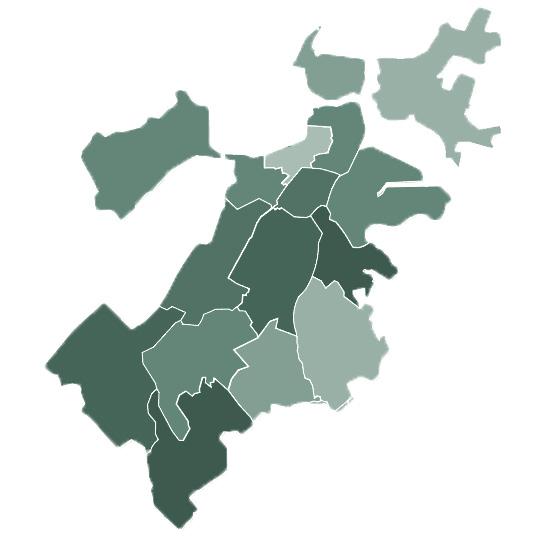
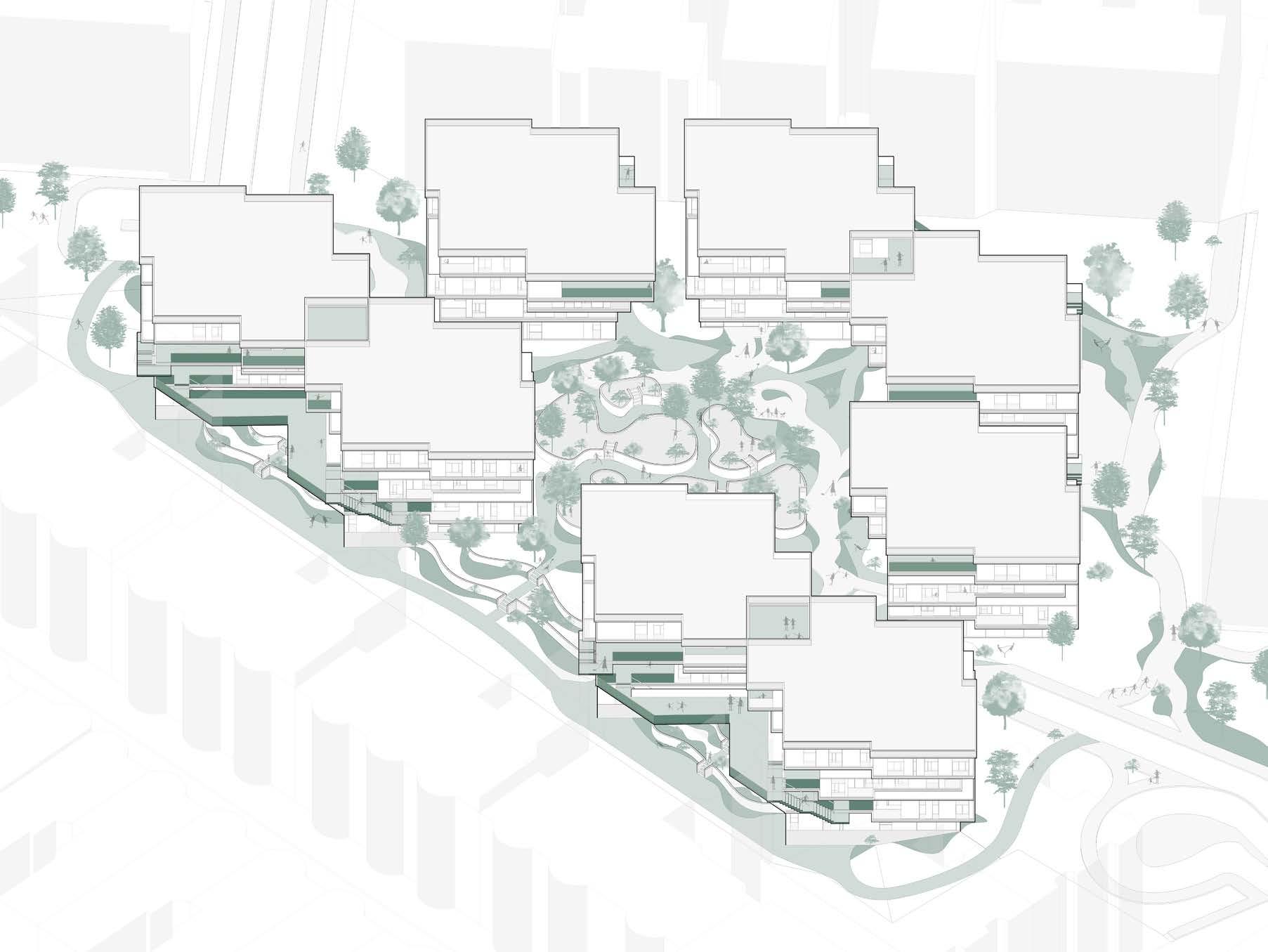
How can we interlace student housing, a strong sense of community, and nature? The Paisagismo Jarvis housing project attempts to achieve this by bringing the beauty of the emerald necklace and community-oriented design to Northeastern University’s campus. This concept can be translated on a micro and macroscopic scale, from mindful unit configurations to intersection-focused site design.
Taking from the meandering path that the portion of Boston’s series of parks known as the “Emerald Necklace” takes on near the Jarvis Street site, the Paisagismo Jarvis housing complex emulates this form by doing away with the originally planned ‘Jarvis Street’ that was intended to cut horizontally through the site, taking on a network of equally winding footpaths in a Burle-Marx-esque fashion.
Both to allow the complex to take on a more intimate relationship with the natural environment and to balance between keeping the site navigable yet ecologicallyfocused, the use of impermeable surfaces is minimized with a wide distribution of permeable and impermeable surfaces. the incorporation of features such as phytoretention mats and bioretention swales come to be especially important given the site’s context and its susceptibility to pollutants from nearby vehicular traffic.
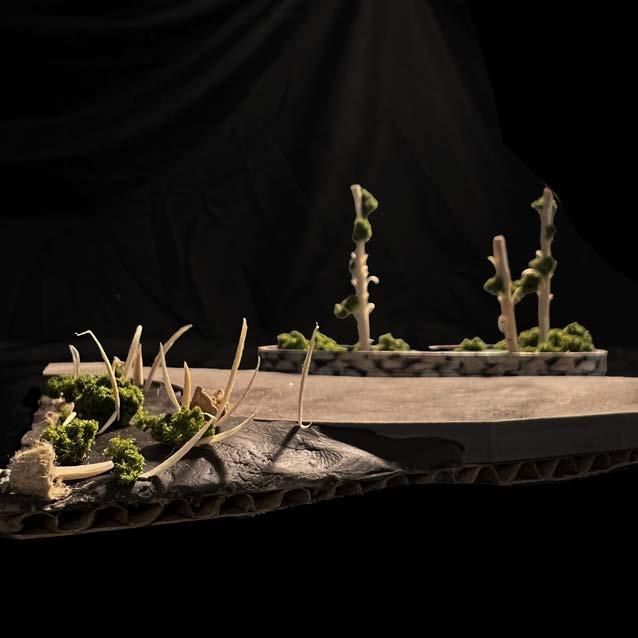

Model of site showcasing all 4 pavement types.
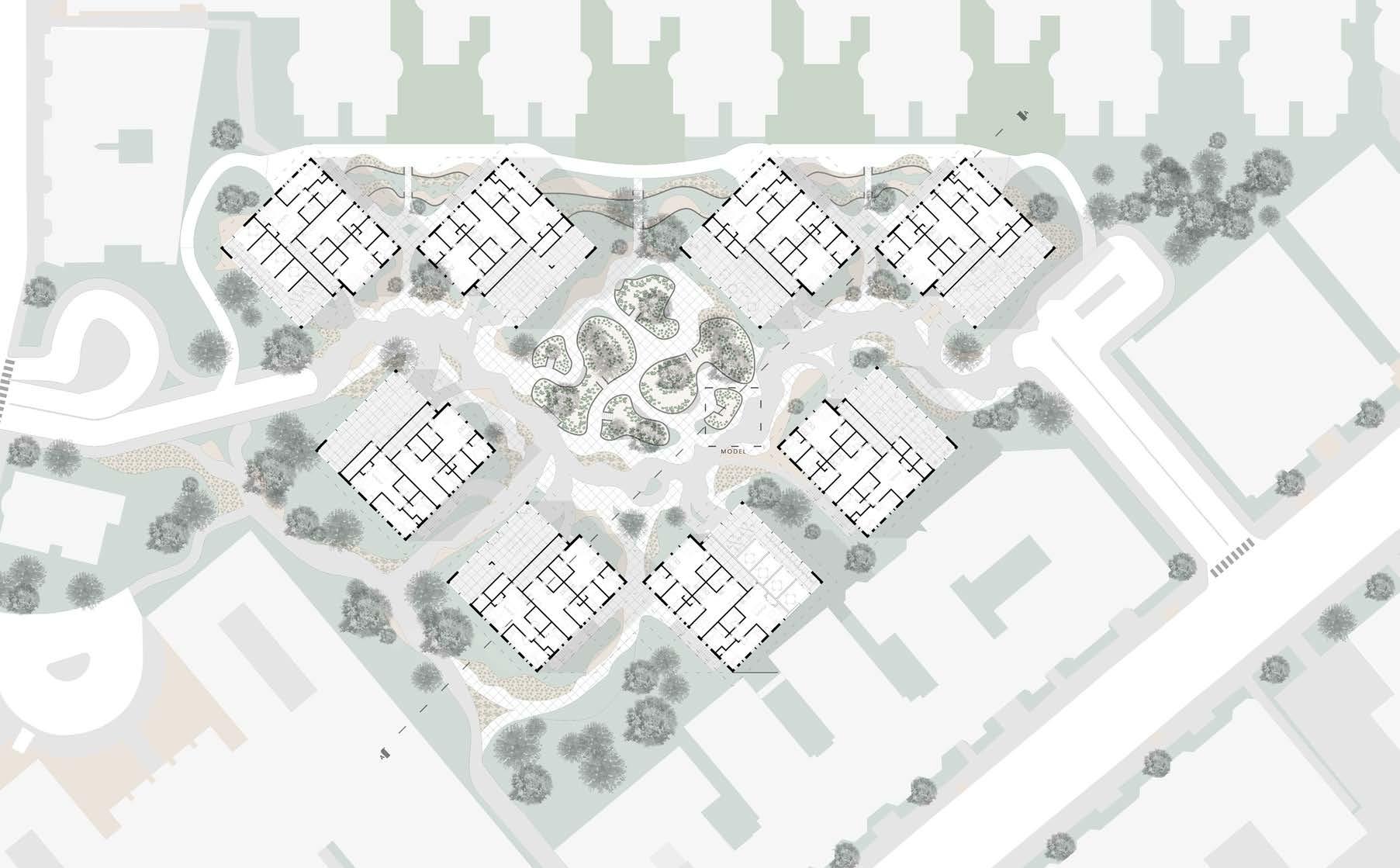



At the heart of the complex is a central square surrounded by six buildings, with all four pavement types converging around elevated garden beds. This open plaza adds lush greenery and offers residents space to plant their own gardens. Beyond its aesthetic and ecological appeal, the square acts as a central hub, allowing pedestrians to pass through as it anchors the path network.
The complex fosters connections at various scales. Publicly, exposed staircases weave between buildings, connecting to terraces that serve as semi-public “front porches.”
On a more intimate level, duplex units share terraces with neighboring apartments, while family units feature dual living spaces to accommodate growing families, giving children their own “living room” connected to other domestic areas.



The design of this complex emphasizes intersection-oriented layouts to encourage interactions among its diverse residents, including graduate students, single individuals, families, and those in affordable housing. This approach counteracts the isolation often found in densely populated urban housing projects. The design promotes encounters through various scales: large circulation paths that intersect throughout the complex, vertically meandering staircases and porch-like halls in each building, and cluster units on the upper floors of each building.
Responding to Boston’s housing crisis and housing code, each of the six buildings includes three duplex cluster units with ample living spaces, accommodating five bedrooms and two bathrooms. This design reflects the growing trend of micro-housing in cities worldwide while prioritizing intimacy and community among residents.

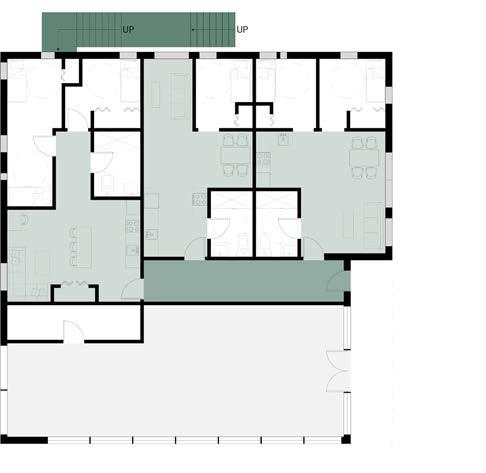


Aside from aesthetic, ecological, and sensory appeal, the square also serves as a central intersection for residents and commuters alike, allowing pedestrians to slip past one another as they move through the complex - as if the square is the center of the path network’s axis.
Intimate connections are seen on multiple scales within and between apartments. Most publicly, throughout each building an exposed staircase weaves in and out of the building, starting and landing at public terraces that act as a ‘front porch’ type of semi-public space. Then, the largest third to fourth floor duplex cluter units share a terrace with the corresponding apartment in the adjacent building. Most intimately are the open layouts of the cluster and family units, in which ample living space is provided to residents in anticipation of increased occupation. This is seen in the feature of dual-adjactent living spaces in family units to allow children a ‘living room’ of their own attached to the rest of other centers of domestic activity.
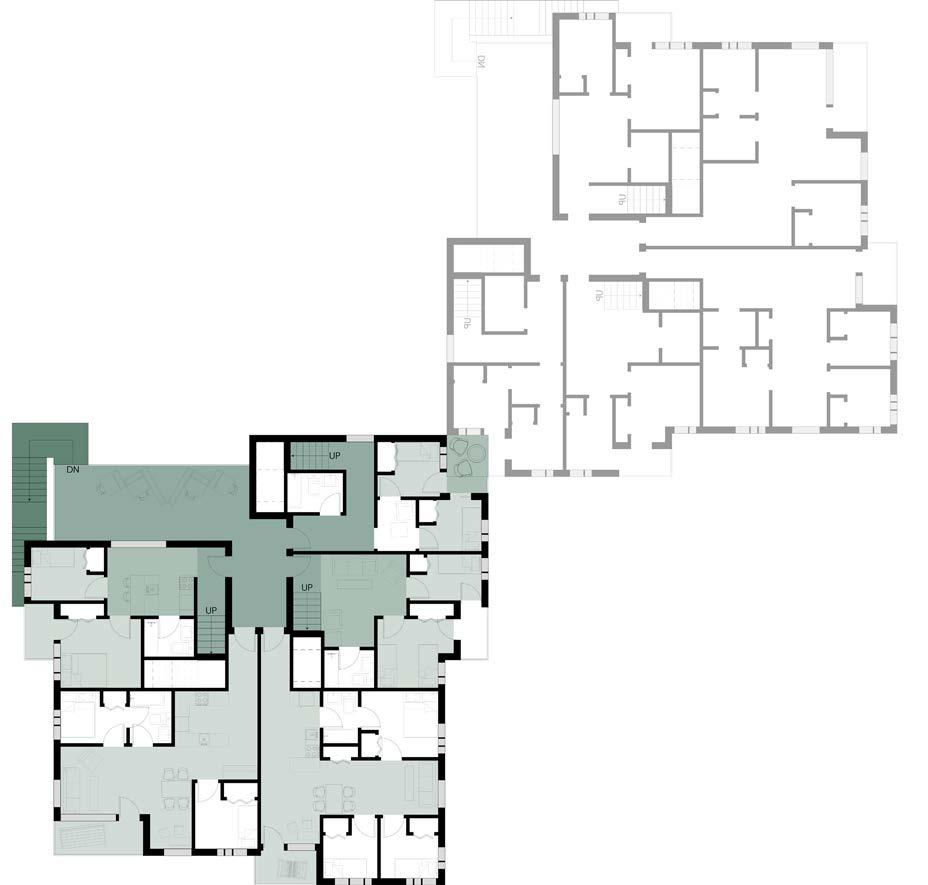
IN COLLABRATION WITH AUSTIN LAW, MERCEDES MARTÍN, AND NISARGA RAMESH
DESIGN STUDIO V AT IE UNIVERSITY • FALL 2023
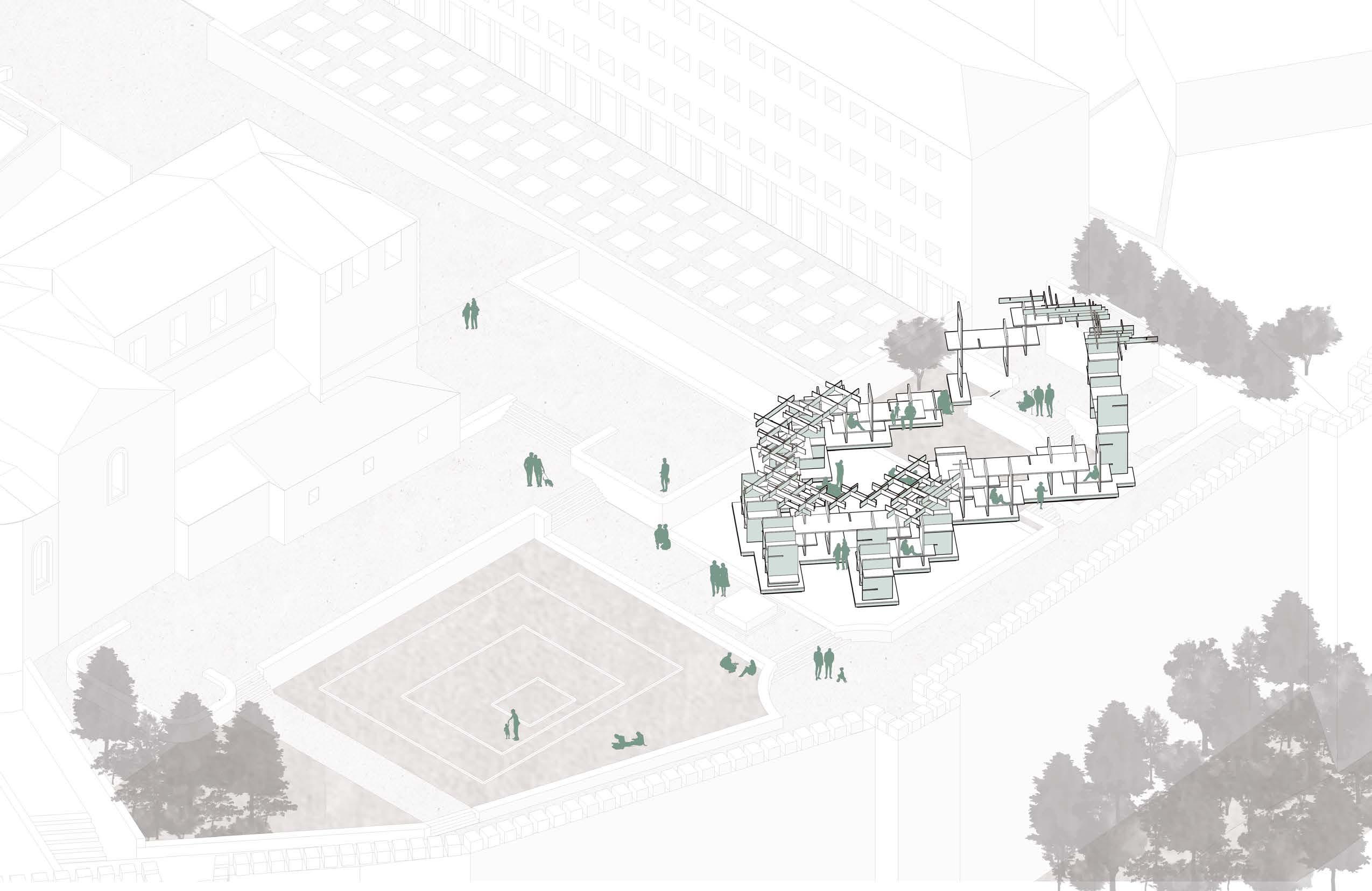


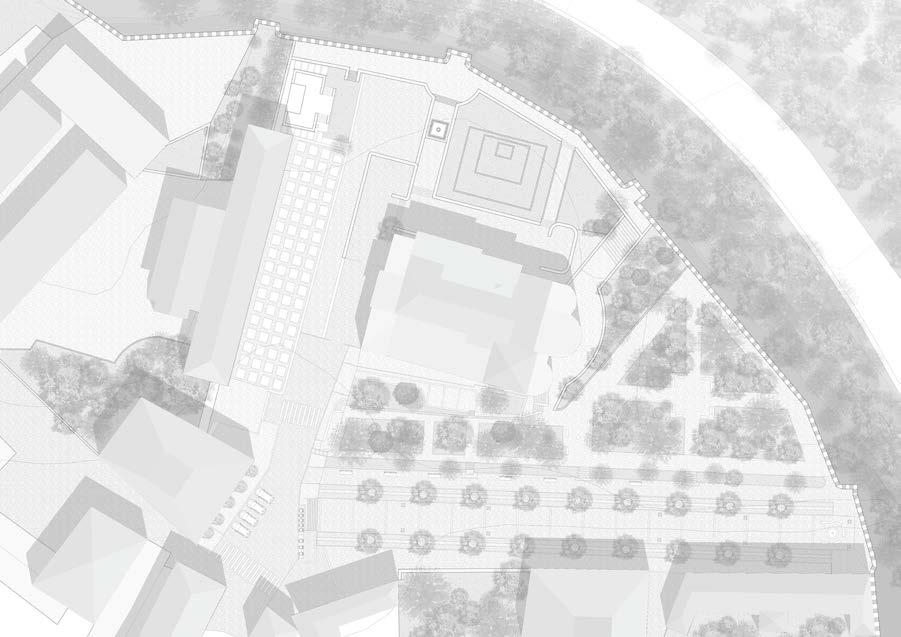

The Jardines de Los Zuloaga are a park and public perfomance space adjacent to the Museo Zuloaga, a cultural center founded by ceramicist Daniel Zuloaga. The garden sits along the medieval wall of Segovia, sporting beautiful views of the surrounding landscape.

Within the garde is a stage, which currently remains unused despite the area’s frequent use as a performance space for community events. Instead, performers typically set up on the lawn of the garden, bringing along their own equipment to build makeshift stage spaces.
Our intervention attempts to address this shortcoming by introducing an installation to the garden that highlights the existing stage, allows for audience spectatorship, and respects the uniqueness of the space’s circulation strategy and one-of-a-kind view.
To introduce us to temporary pavilion construction, we recreated construction drawings of the “Forests of Venice” by Kjellander Sjöberg and built a 1:4 scale model of a quarter of the pavilion.
This process allowed us to study its construction methods, including a system of balanced joints that enable the upper structure and roof to cantilever with minimal fasteners. Through research and model analysis, we determined the use of pocket screws to secure layers diagonally.
However, we noted some issues: inefficient space use, with inaccessible upper levels, and a reliance on pocket screws that undermines the design’s focus on balance. Additionally, the use of imported Swedish pine, though intended as a tribute to Venice’s historic piles, seemed inefficient.

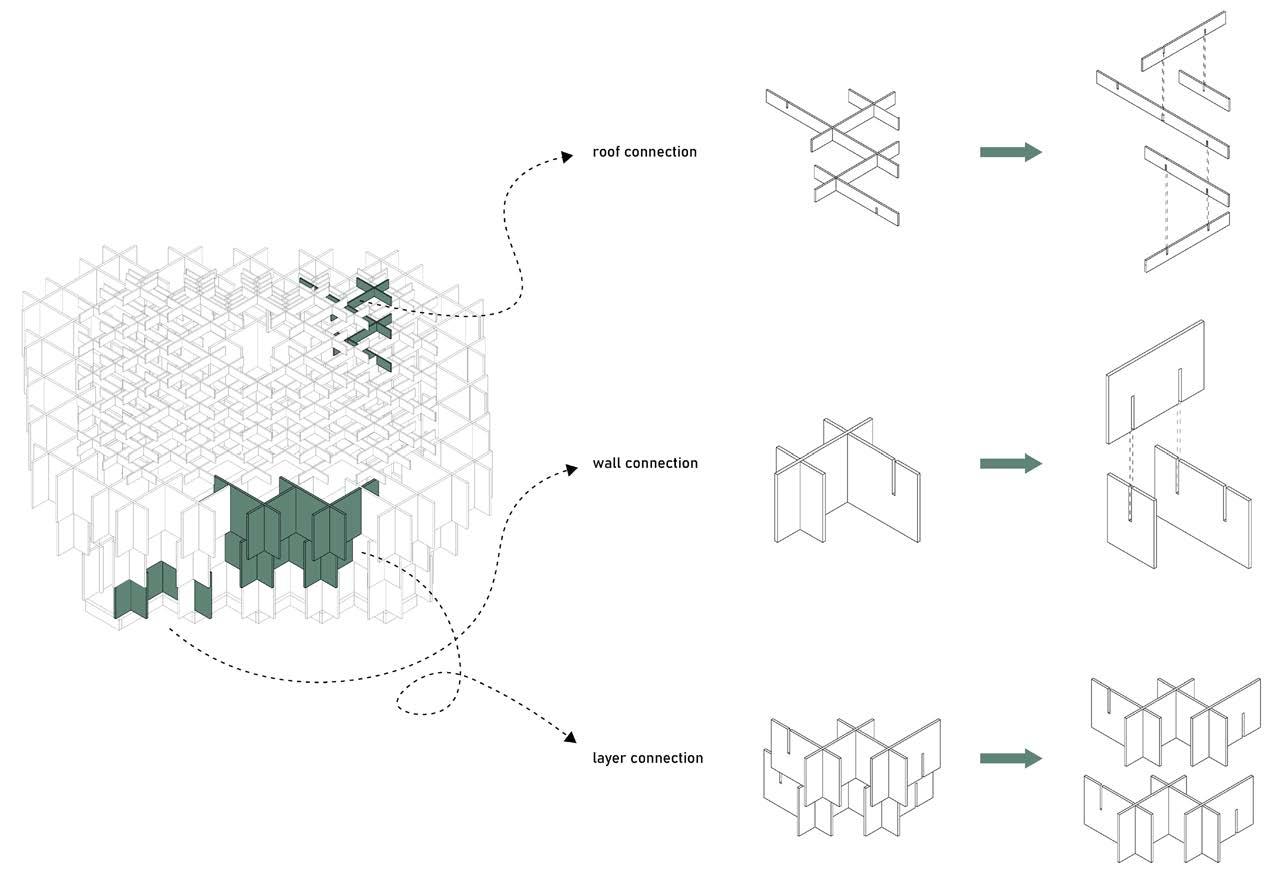
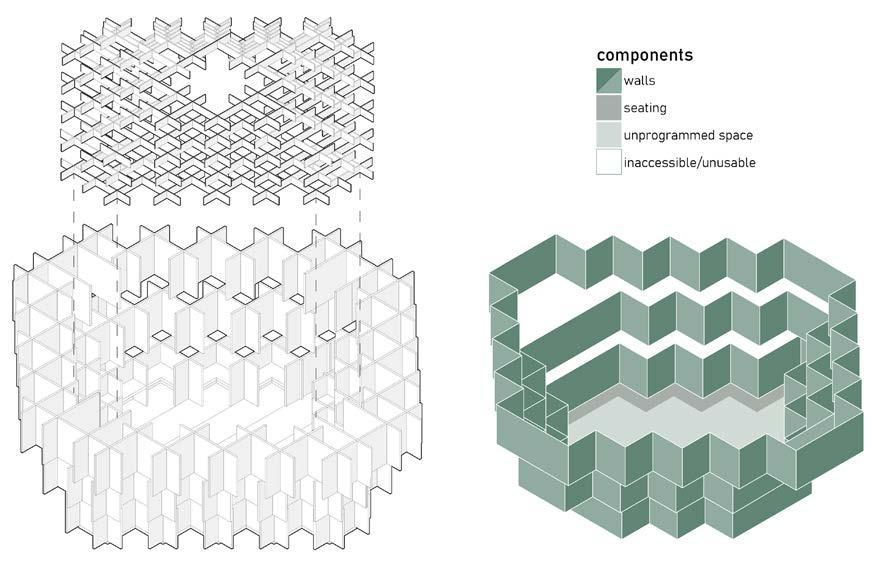
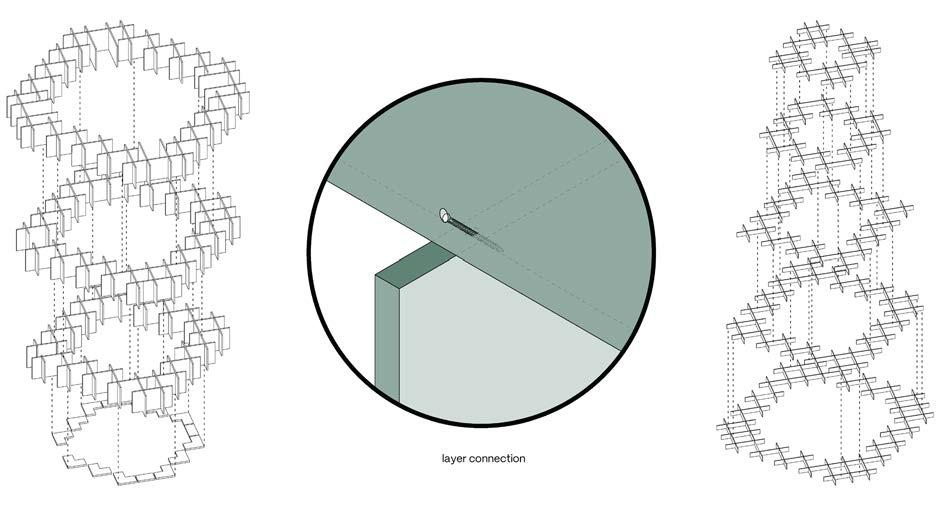
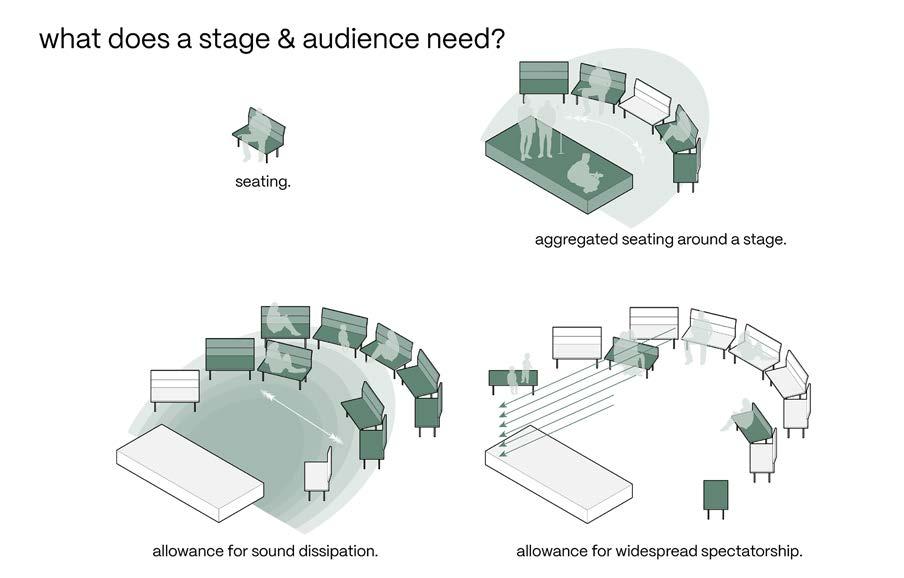

Reusing elements from the Forest of Venice, we developed five modular units, leveraging the replicability of the original pavilion’s connection strategies. These modules defined vertical and overhead planes, forming an amphitheater-like structure that framed the stage, created additional seating, and provided shade for spectators.
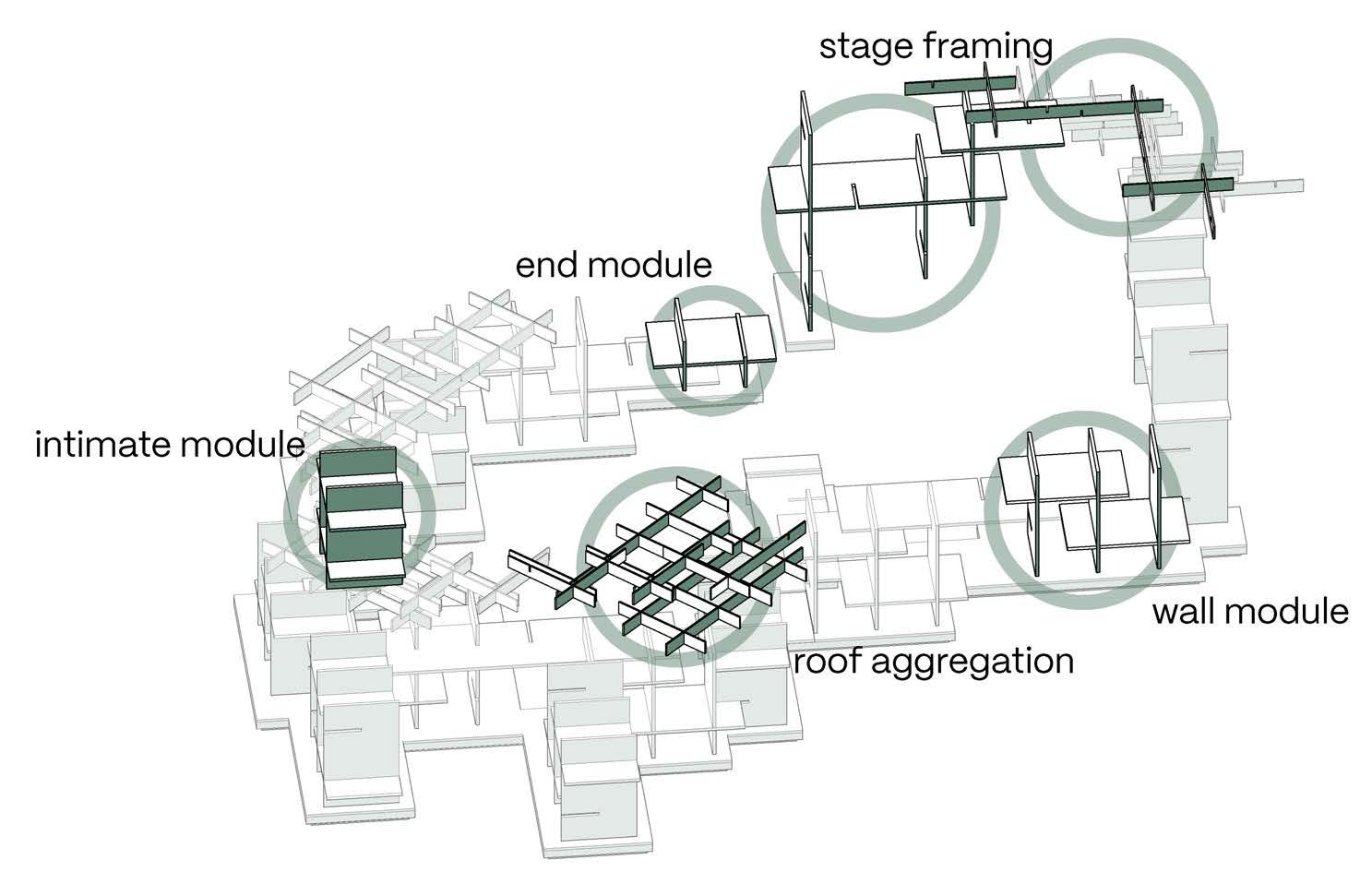
Our design for the new pavilion, using the same materials, addressed both the programmatic limitations of the Forest of Venice and the site’s circulation. To enhance the stage setup, we analyzed the needs of the audience and stage, shaping our intervention accordingly. Inspired by the circulation strategies of Japanese gardens, we guided user movement through and around the structure, aligning with the site’s landscape views.

Each of the different module types were born out of pre-existing repeated ‘modules’ found throughout the Forests of Venice.
We first created the ‘intimate’ module, which created a smaller-scale “nestled” space that would allow users to sit and view performances with more privacy from others. The compactness of this module also aided us in creating an overall layout for the structure.
Afterwards, using only one extra piece when compared to the intimate module, came the ‘wall’ or ‘flexible’ module that allows for both seating within the module and for users to pass through the ‘walls’ of the pavilion through an archway. Further, the two exposed joints allow for two wall modules to be connected to create a corner.
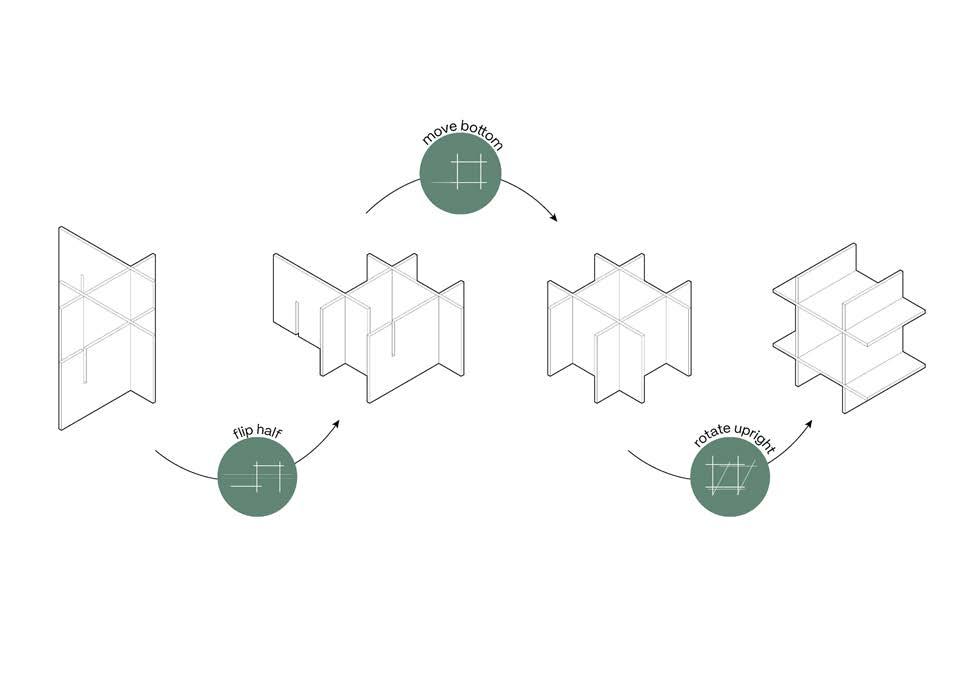
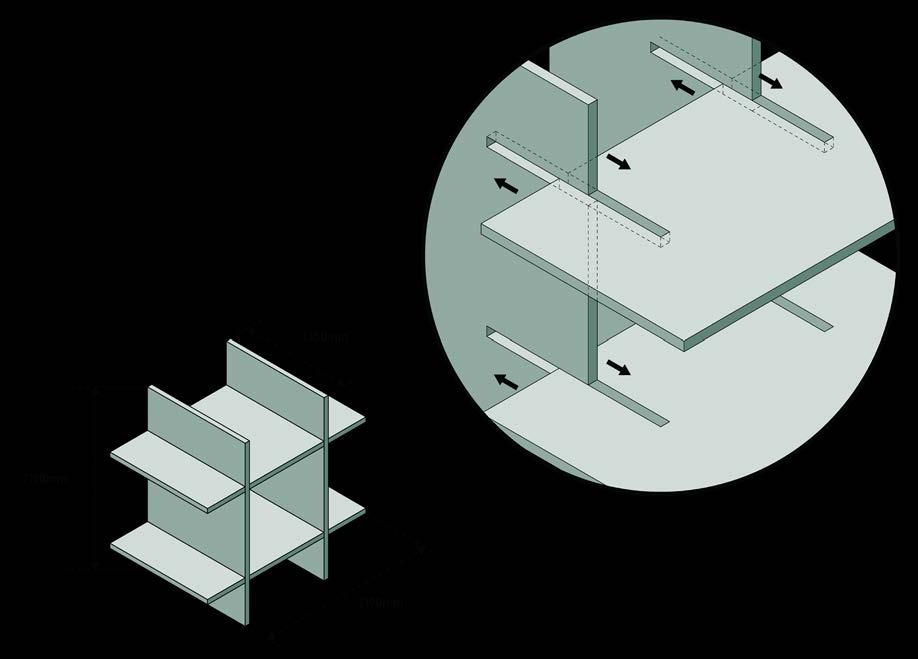

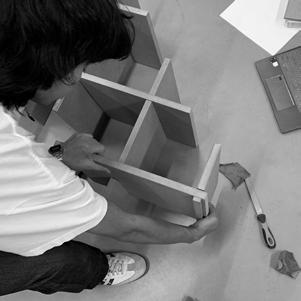

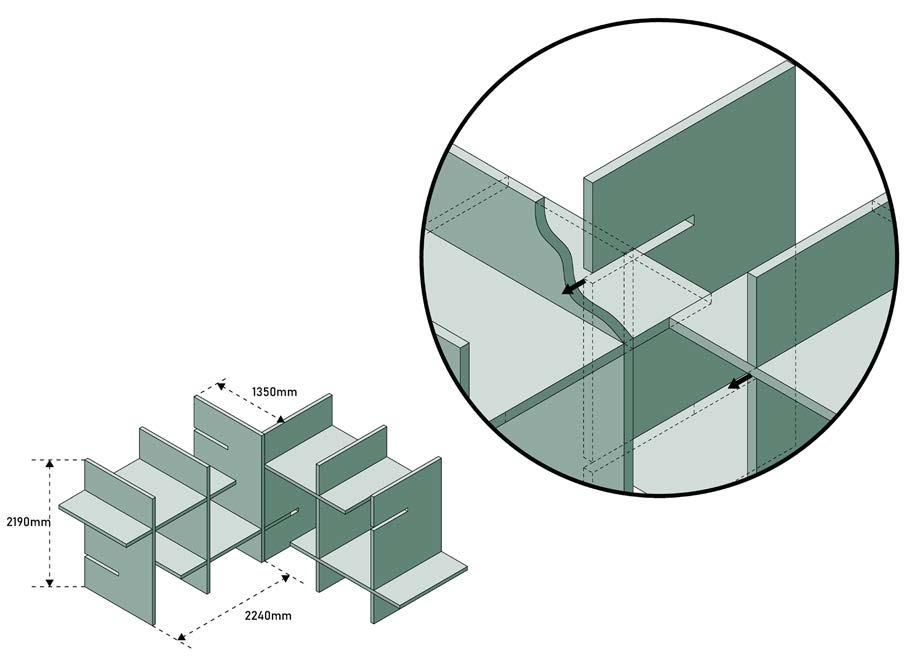
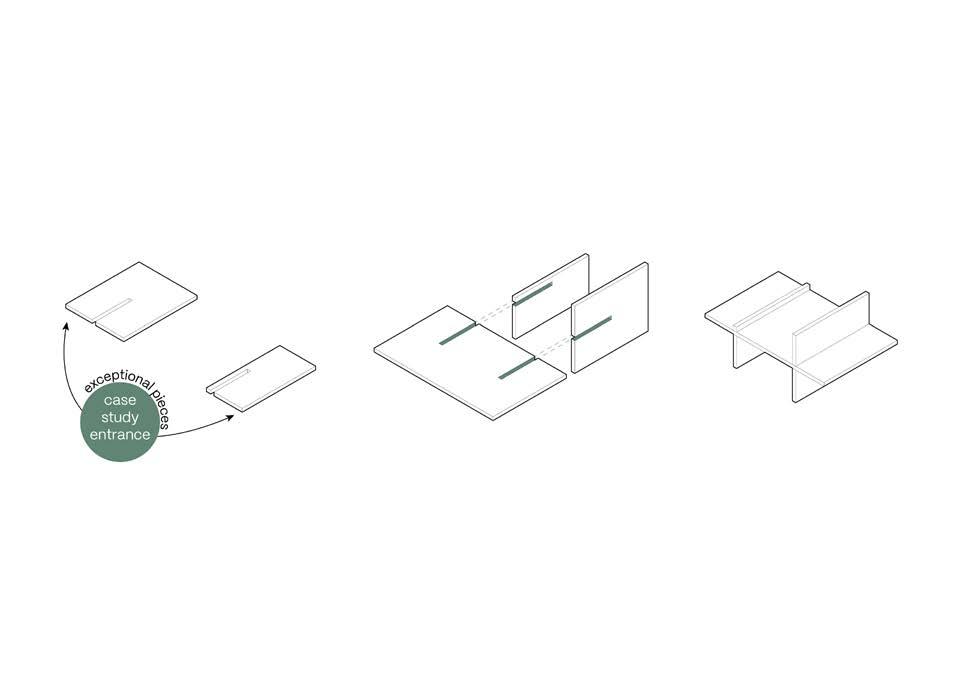


In Kjellander Sjoberg’s construction of the Forests of Venice, a number of wall pieces were cut to create an opening for the pavilion’s entrance. To accommodate for these ‘anomaly pieces’, we took advantage of the short length of the pieces to create the ‘end module,’ as these pieces would not have their view of the stage obstructed in any way - allowing us to place it at the front ends of the seating area.
Taking advantage of the semicircle shape of the seating area, we used a similar logic to the Forests of Venice’s strategy of balancing members to create a cantilever roof to create our own roof modules. We created smaller semicircle modules, also interwoven using the logic behind the hinge system of the structure, that balanced on top of the wall/seating modules and each other to form a stadium-like cantilever roof.

To create further continuity in having our design feel connected to the a stage, we used some of the larger four and five-notch pieces to climb up the stage and ‘frame’ it. This rather decorative element is also connected to the larger structure via a doorway to the side entrance of the amphitheater.
(Shown Below)

In order to aggregate the modules that we’d created to form a singular, interconnected system, we defined a catalogue of allowable connections between modules. Two out of three of these connection types utilize the larger three, four, and five-notch pieces to span larger distances to create larger archways and opportunities for platform seating.
In addressing the aggregation of roof modules, we used lattice-arrangement roof pieces to serve as a bases for the typical roof modules. Semicicular roof module pieces are layered on top of one another, with layers with larger spans placed on top to use its weight to balance the entire system.
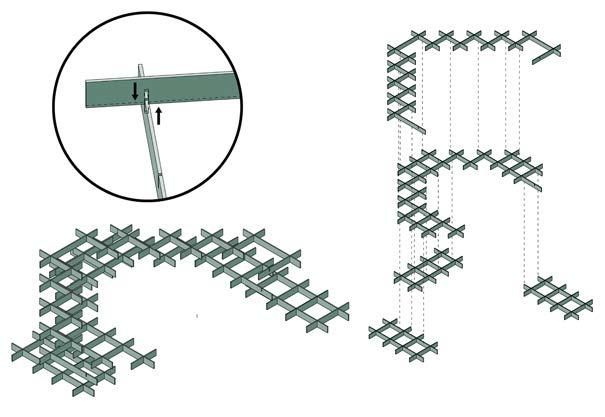
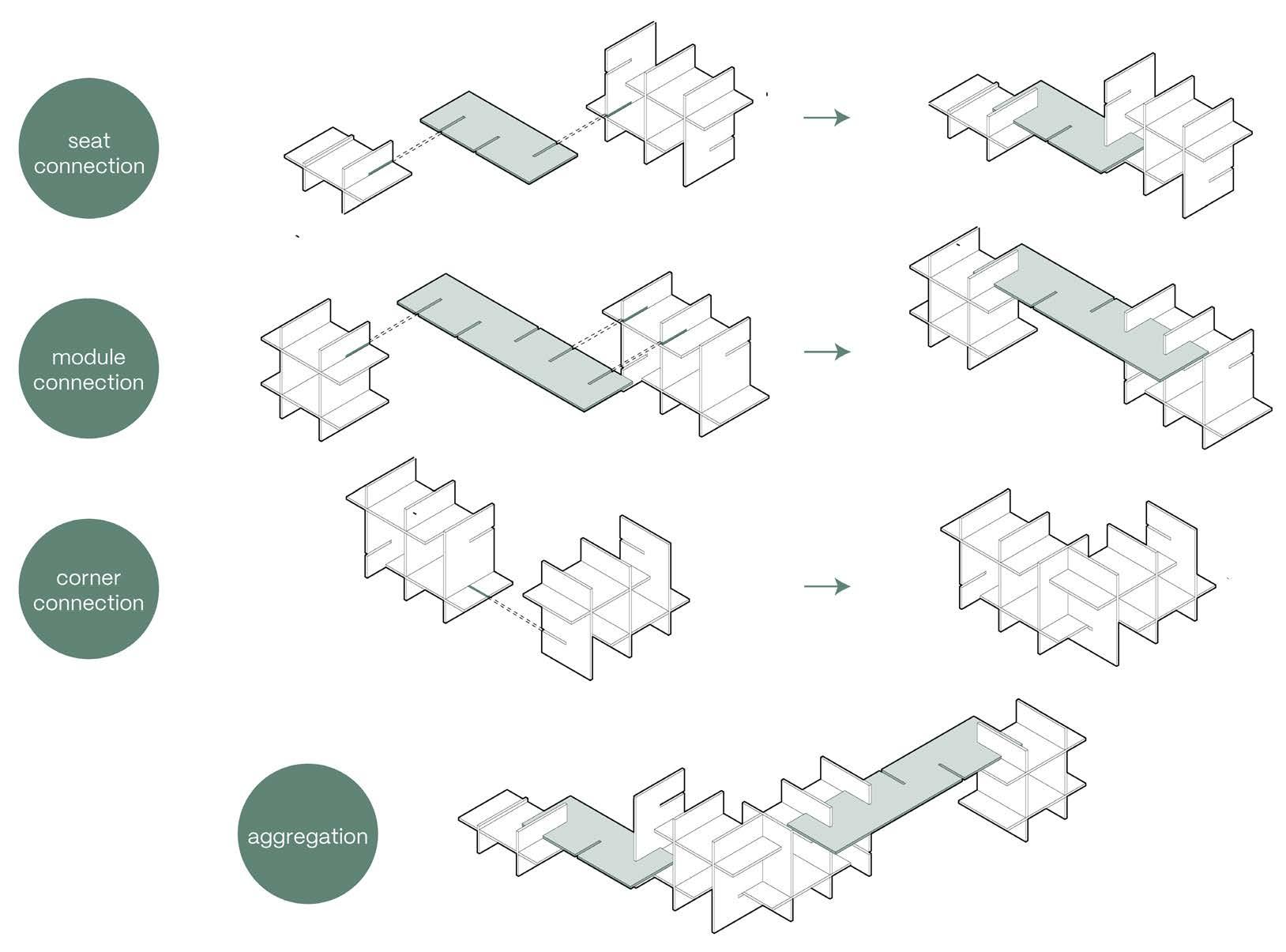
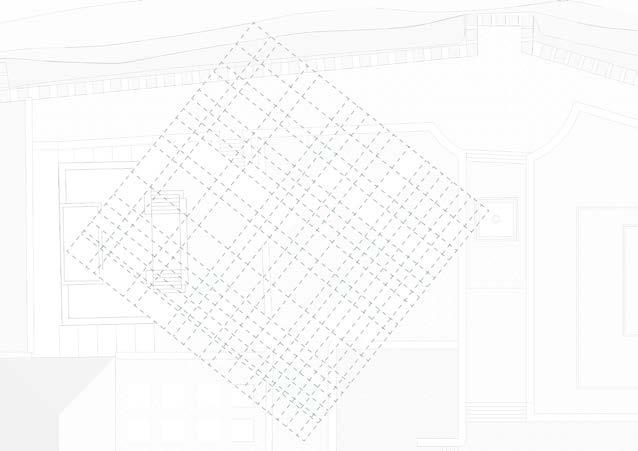
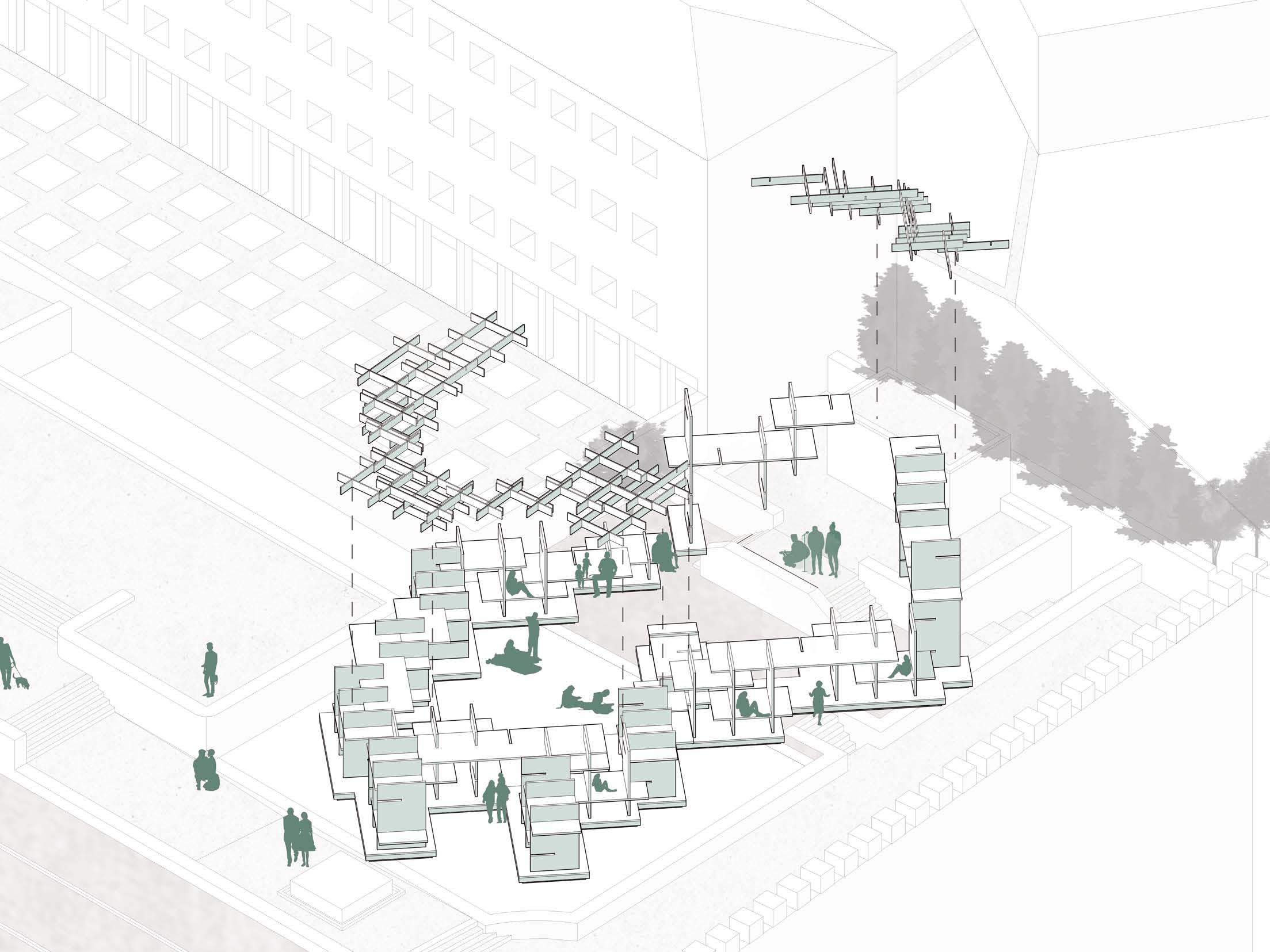
To organize our modules, we used a diamond-shaped grid centered on the stage, allowing each module to orient towards the stage while maintaining structure. This grid helped form our amphitheater layout, with shorter modules at the front. To span the amphitheater’s width, we aligned the roof pieces with the stage.
Since the structure sits on a grass lawn, we devised a simple foundation of a wooden floor plate and steel I-beams to protect the wooden members from moisture. L-brackets secure the wall pieces to the floor plate, which is then attached to the I-beams with screws. Though this foundation deviates from our interlocking wood design approach, it was necessary for structural integrity and minimal visual impact.
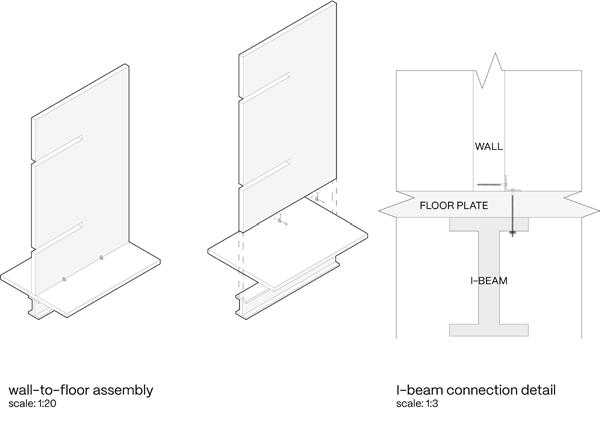
To represent our design physically, we created two models at 1:500 and 1:4 scales. Our smaller model, shown on the left is able to most effectively show how light passes through the amphitheater’s roof structure, with the sunlight dissipating through the roof layers - creating a canopy-like effect.
Attention to site detail and capturing the unique circulation armature of the site were key in our representation. The small scale of the model also demonstrates how the amphitheater is able to provide varying levels of porosity when moving between the site, the pavilion, and accessing the view over the wall of Segovia.


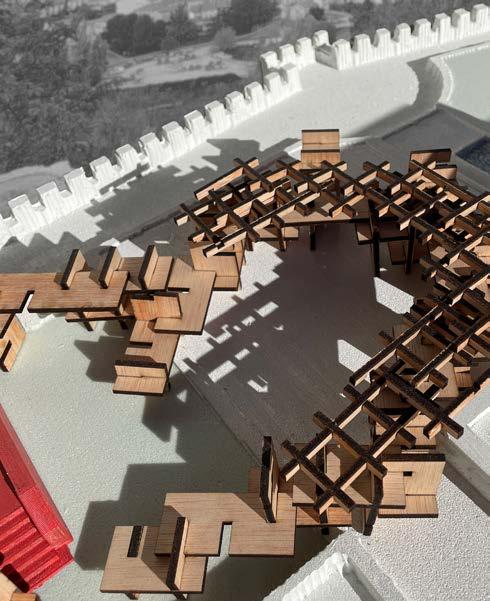
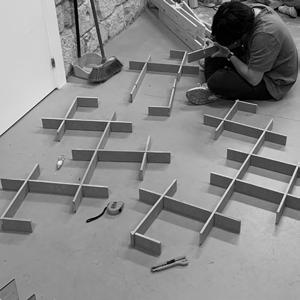

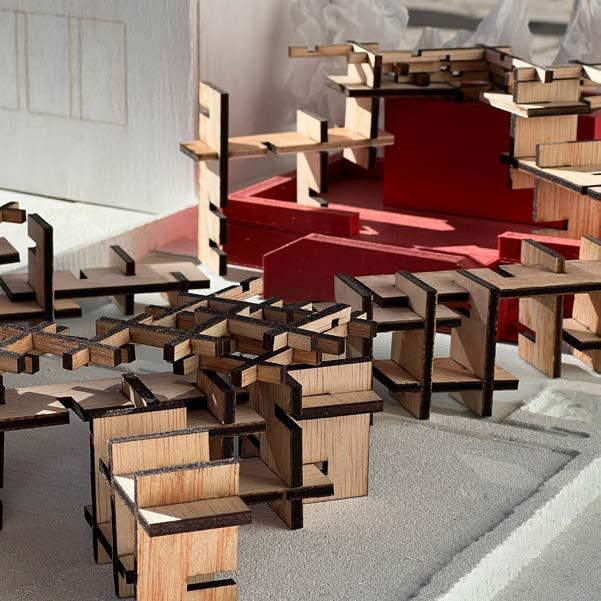
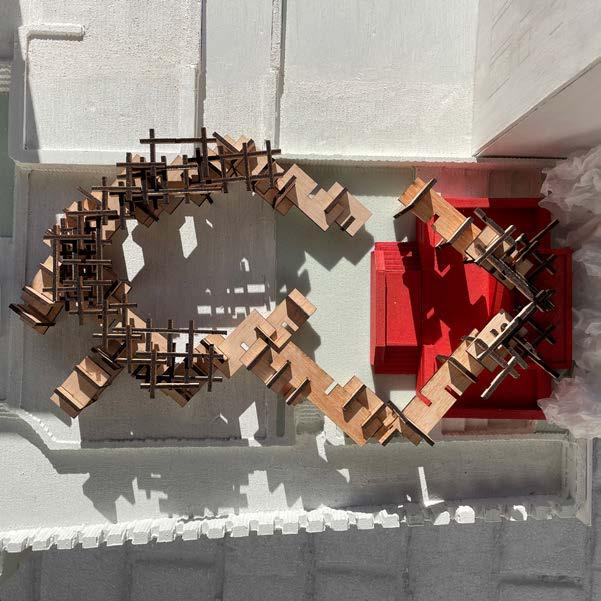
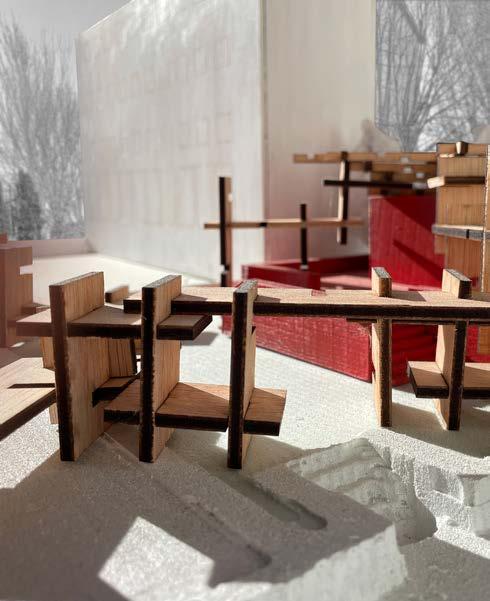

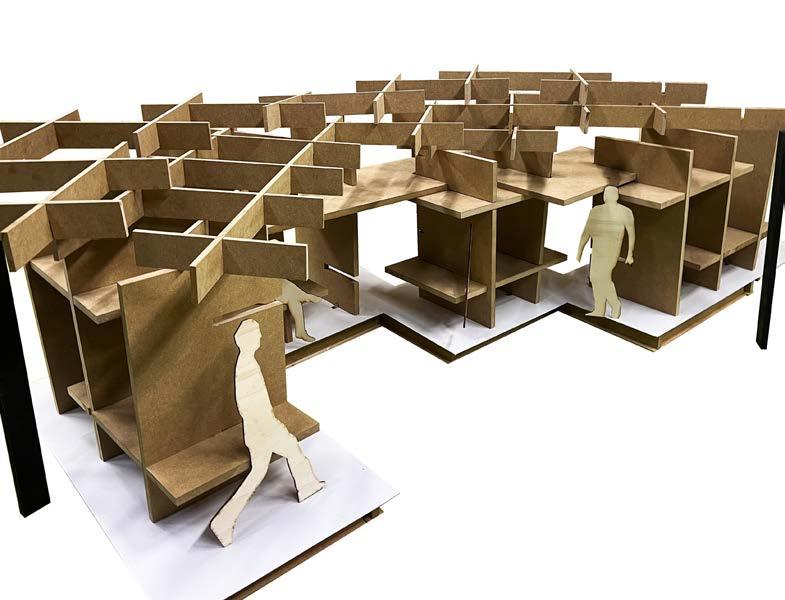






For our 1:4 scale model, we represented three of the ‘flexible’ units and one of the ‘intimate’ units. With this, we were able to follow our catalogue of allowable connections to aggregate the modules we’d made to show the corner connection type and woven uphead module connection type.
Because we were tasked with only using pieces salvaged from our original model of the Forests of Venice, our rendition of a portion of the roof system needed a supplemental support as it would not stand without the rest of the system present, as its stability depends on the entire system being present.
Having meticulously examined the playability of various park designs in Roxbury, my decision to undertake the redevelopment of the Crawford Street Playground was driven by a multitude of factors. Presently, the existing play area is woefully inadequate in both size and imagination, failing to cater adequately to the local population. Furthermore, it overlooks a unique natural feature: a gentle slope that exists within the park, which has been entirely neglected in the current layout.
In my proposal, I envision a comprehensive transformation of the Crawford Street Playground, one that transcends the conventional notions of a playground’s purpose. Not only will it introduce a more spacious and accommodating layout for the playground equipment, but it will also harness the park’s natural slope to introduce an innovative dimension of play. This unique approach will enable children to engage in both horizontal and vertical play, adding an exciting and enriching dynamic to their outdoor experiences.
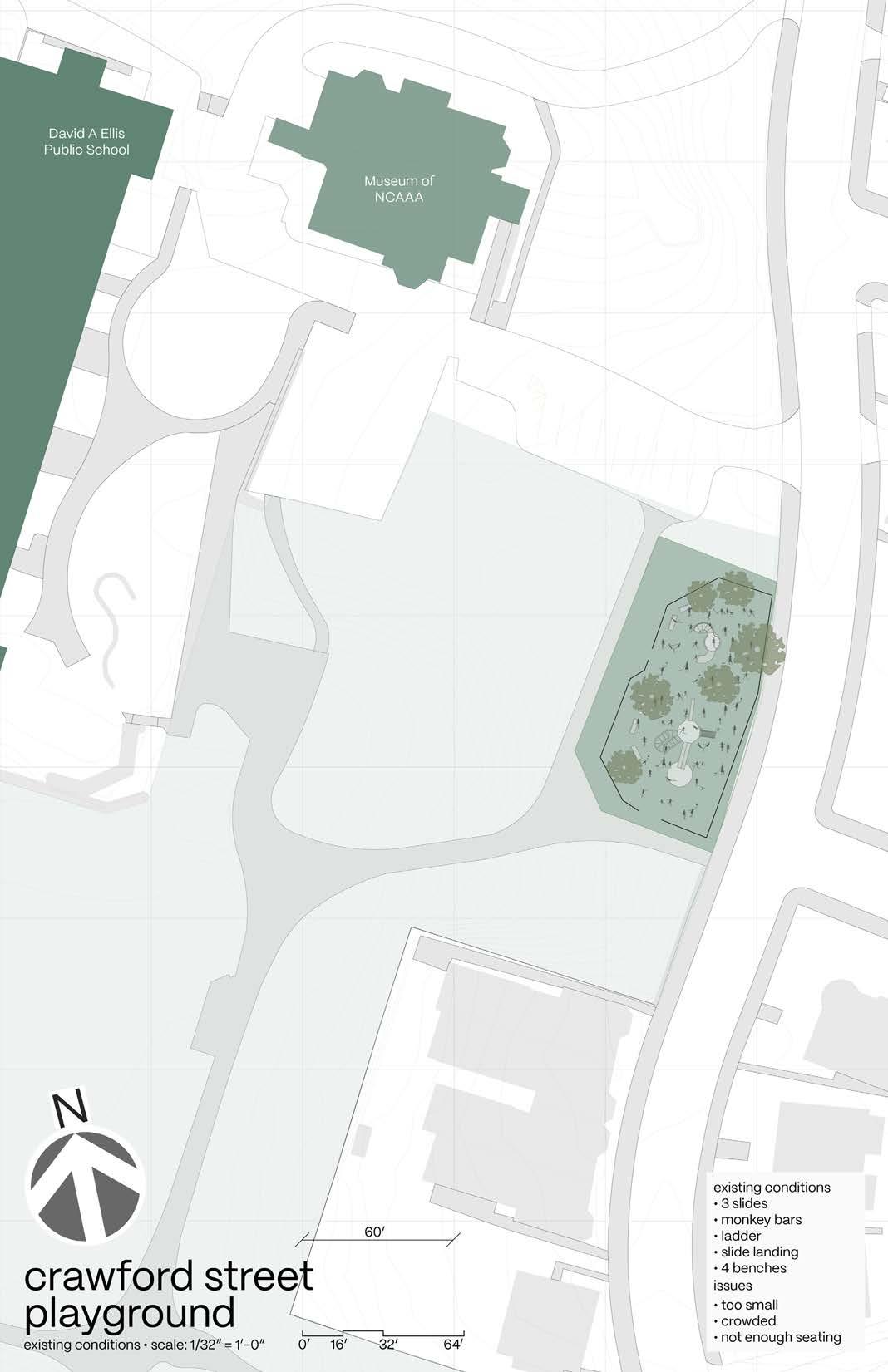


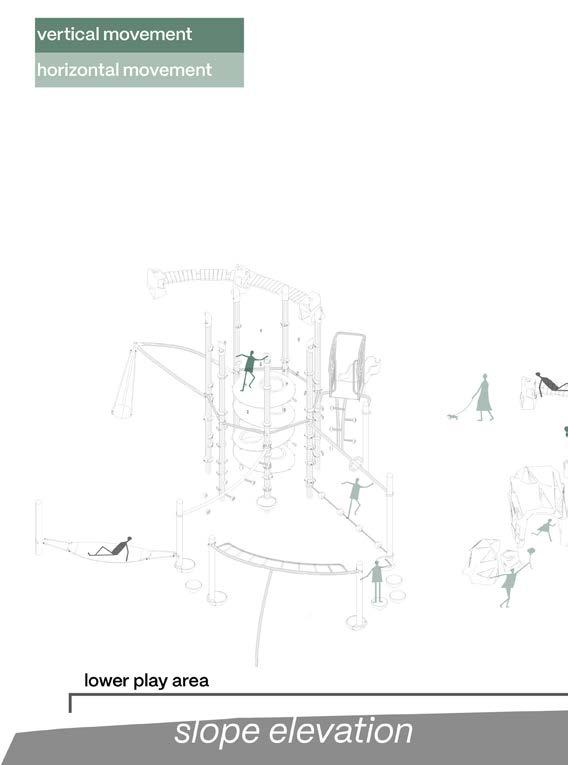
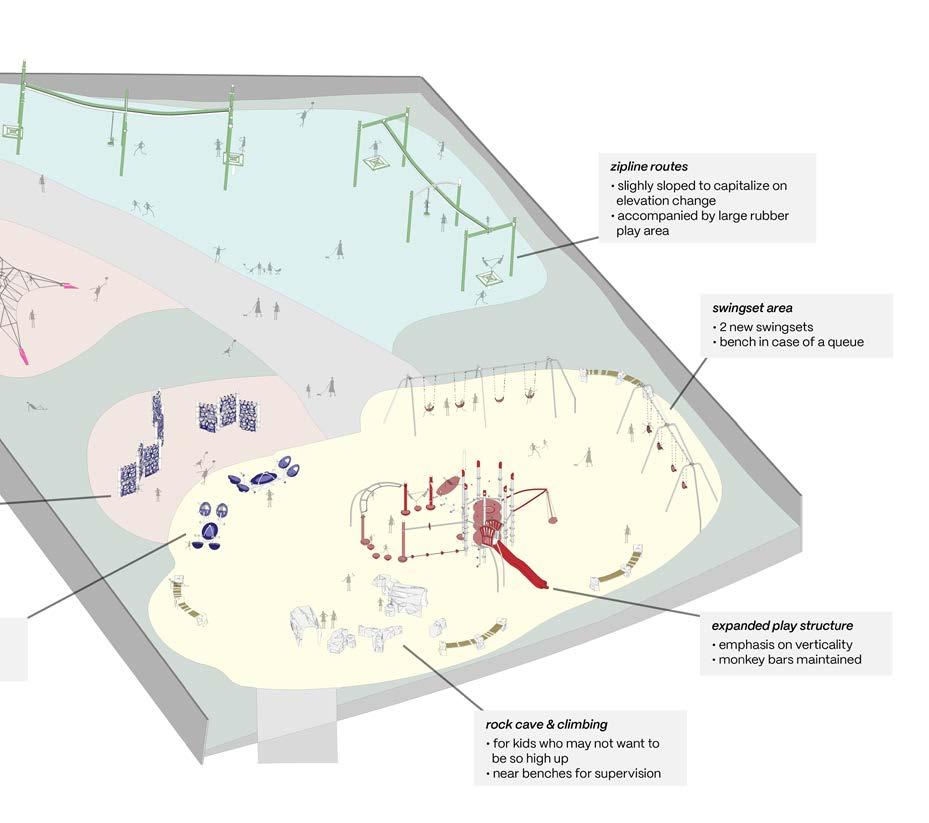

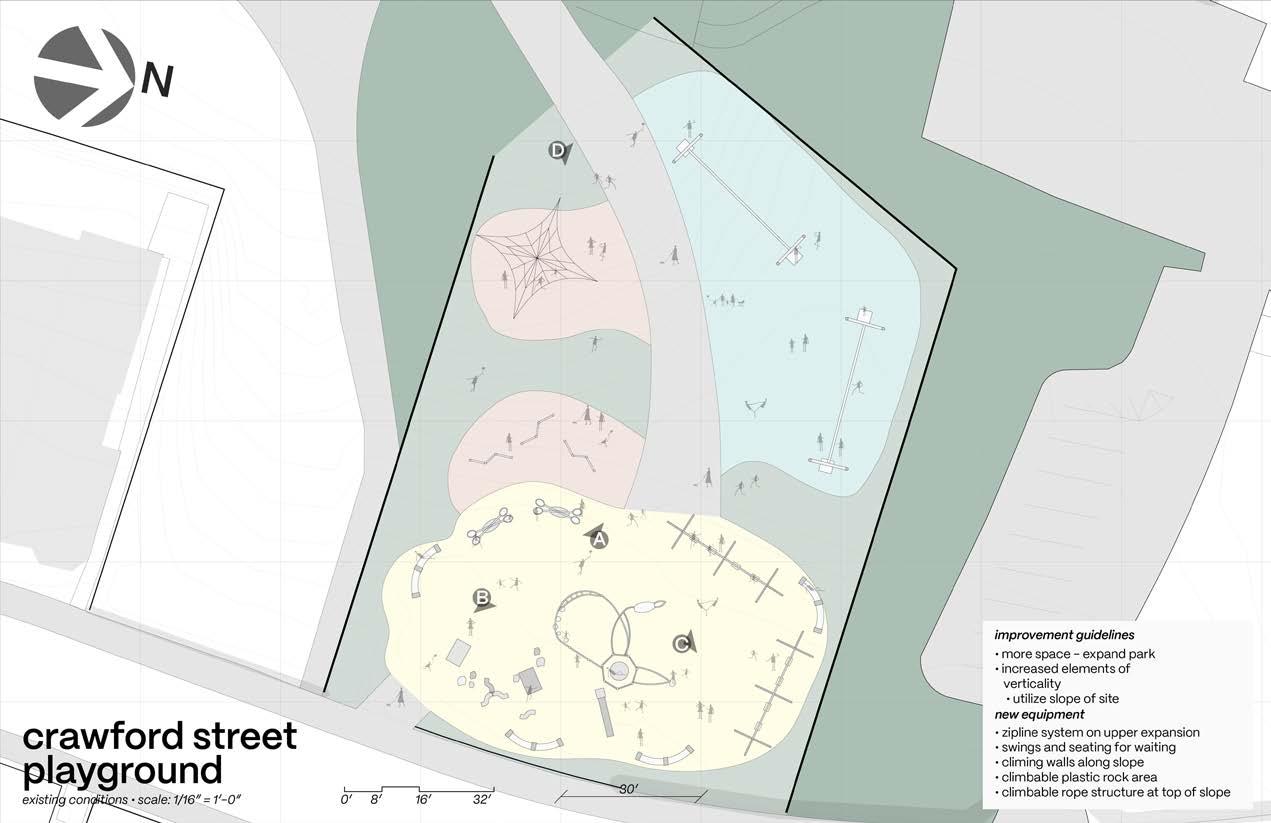

The inspiration for this emphasis on vertical play stemmed from insightful suggestions provided by elementary-age students attending Boston Public Schools. When we asked these young minds about the features they wished to see in their own elementary school’s playground, many expressed a keen interest in activities that embraced verticality. Recognizing the potential to make their dreams a reality, our design seeks to integrate this input, ensuring that the Crawford Street Playground becomes a vibrant, imaginative, and inclusive space where children can explore, learn, and grow.
Our vision for the Crawford Street Playground embodies a commitment to creating a safe, stimulating, and communityoriented environment. By harmoniously blending contemporary design principles with the spirit of innovation, we aim to craft a space that not only fulfills the immediate recreational needs of the neighborhood but also inspires a profound sense of wonder and discovery in generations to come. This project represents a unique opportunity to transform an underutilized space into a cherished community asset, and we are excited to embark on this journey of revitalization.
To demonstrate how kids can also interact with their built environment through modelmaking, a 30’x30’ section model of my proposal and two pop-up book spreads demonstrating how play can occur in my proposed park (all interactive) were created and presented to a class of Boston Public Schools elementary schoolers.






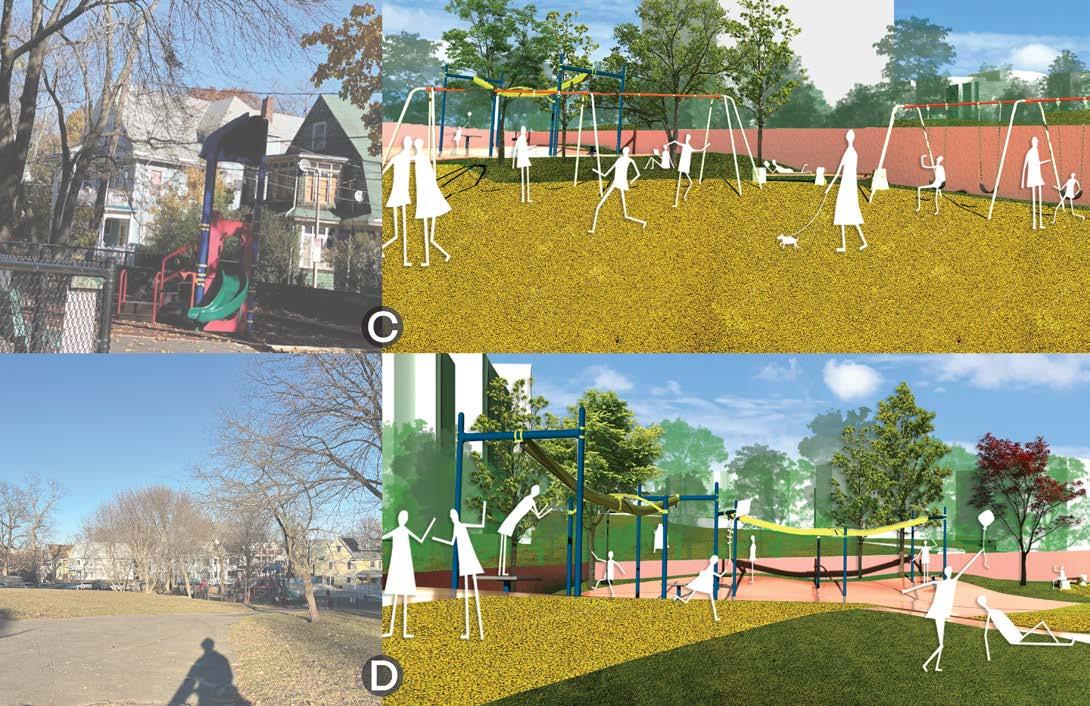

Render Location Guide
Thanks for reading!
There’s lots more to see... See my full portfolio here:
